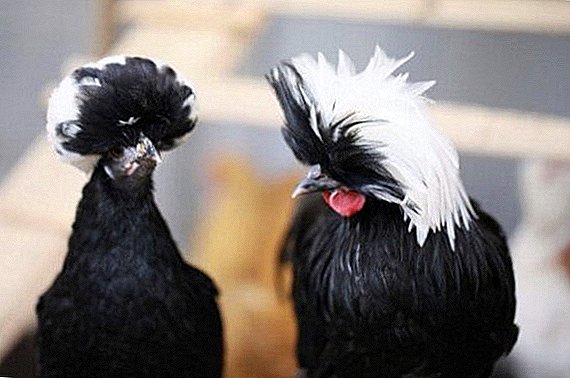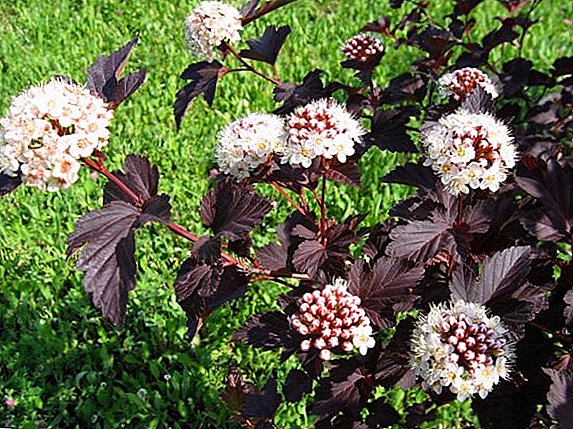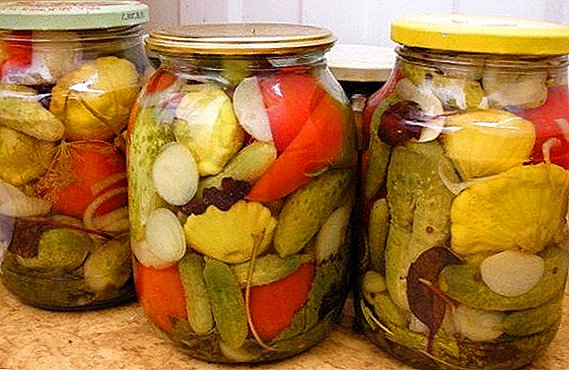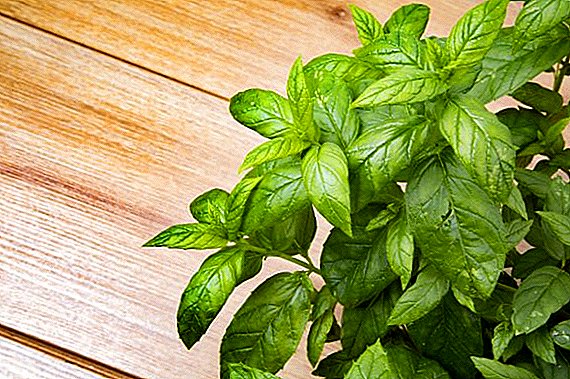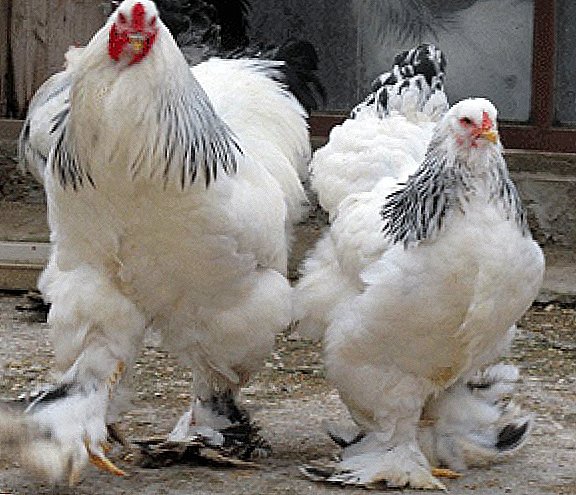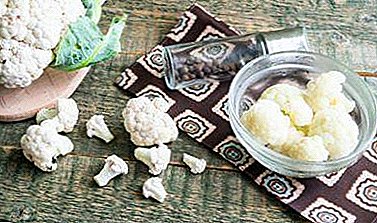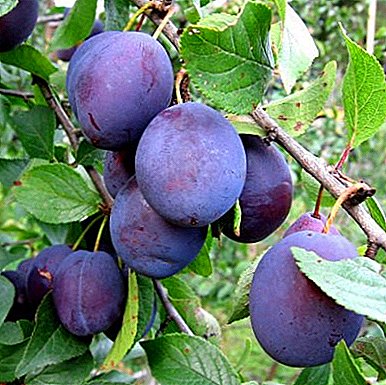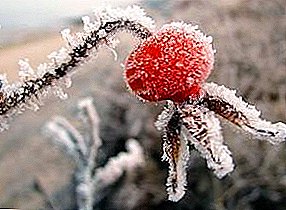 Begonia Cleopatra - one of the most popular indoor flowers.
Begonia Cleopatra - one of the most popular indoor flowers.
How to carry out the right care for him, as well as the difficulties that may arise during home cultivation, read below.
Description of indoor plants
The plant belongs to the Begonian family. In the wild, it is found everywhere in subtropical and tropical forests.
Did you know? Tubers of many varieties of begonias are suitable for food. They have a pleasant sweetish taste with a citrus shade.
Cleopatra begonia is a short-growing plant, reaching a maximum of 30 cm in height. It refers to herbaceous perennials. Shoots collected in the rosette. Stems erect, covered with not too dense spines. The color of the stem is maroon.  The leaf plates are heart-shaped, obliquely resemble maple leaves. The edges of the plates are split, decorated with teeth. The outer side of the sheet is painted in dark green color. The color may become lighter or darker when moving the plant relative to the light source. The underside of the leaf plate is colored red or burgundy.
The leaf plates are heart-shaped, obliquely resemble maple leaves. The edges of the plates are split, decorated with teeth. The outer side of the sheet is painted in dark green color. The color may become lighter or darker when moving the plant relative to the light source. The underside of the leaf plate is colored red or burgundy.
The flowering phase begins in January, lasts for about a month. Flowers are small, up to 2 cm in diameter, collected in an elongated sprawling inflorescence. The petals are pink, hide the yellow core.
Conditions for growing in homes
When arranging conditions for begonias, Cleopatra should take care of 3 factors:
- find the right location;
- provide favorable temperature conditions;
- adjust the humidity.
Location and lighting
For the growth and development of the flower you need a lot of diffused light. Optimal daylight hours for Cleopatra begonia - 12 hours. It is better to place the plants on the western or eastern window sills.  If it is not possible to provide the correct location:
If it is not possible to provide the correct location:
- set the shading from the midday rays on the south window;
- in the north - fitolamps for additional lighting.
Did you know? In the Himalayas, the locals use the ground portion of begonias as a seasoning for meat and fish dishes.
Temperature conditions
Cleopatra begonia develops at room temperature + 18 ... + 30 ° С, depending on the season. There is no bright rest period for the plant, therefore it is not necessary to further reduce the temperature in the room.
Air humidity
The plant, which came to us from the tropics, is demanding of humidity. The optimal rate is 80%. At the same time, soil moisture should be maintained within 50%, avoiding stagnation of water. 
Home care
Cleopatra is easy to care for begonia, but if you violate some rules, the plant reacts by dropping foliage and flowers.
Due to the fact that the rest period is weakly expressed, it is not necessary to create special conditions in winter. Cleopatra winters at + 18 ... + 22 ° С. The only condition is to maintain a stable high humidity. To do this, the heaters are covered with a damp cloth or pallets with wet charcoal are installed next to the flowers. At the same time, the amount of moisture introduced into the soil is reduced.
Top dressing
Top dressings bring 2 times a month during the spring-summer period. They produce special fertilizer for violets and begonias. It refers to organo-mineral preparations. Also well proven drug "Bona Forte".  For young plants, drugs are diluted in the dosage of less than half than specified in the instructions. From the first year of plant life, the dosage is set strictly according to the instructions. In the middle of summer, you can also use a solution of wood ash (1 tbsp. Per 5 liters of water) and compost infusion (1 tbsp of compost to 5 liter of water).
For young plants, drugs are diluted in the dosage of less than half than specified in the instructions. From the first year of plant life, the dosage is set strictly according to the instructions. In the middle of summer, you can also use a solution of wood ash (1 tbsp. Per 5 liters of water) and compost infusion (1 tbsp of compost to 5 liter of water).
Important! From organic fertilizers for begonias do not use slurry - there is a high risk of burning the roots.
Watering features
Flower watered moderately. When introducing water, you need to gently raise the stems and pour it under the root. In the summer heat watering is carried out once every 2-3 days, in winter - once a week.
The temperature of the water must match the ambient temperature. The tolerance is a variation of ± 2 ° C.  Spraying in the summer spend daily. In September, the plants are gradually transferred to the spraying mode once a week, and next month they stop altogether. If the humidity is low, use moisturizers.
Spraying in the summer spend daily. In September, the plants are gradually transferred to the spraying mode once a week, and next month they stop altogether. If the humidity is low, use moisturizers.
Read more about the features of the cultivation of other types of begonias: Bolivian, coral, elatior.
How to trim and replant?
Pruning begonias is carried out in order to regulate growth, flowering and renewal of the bush. Upon reaching a bush height of 7 cm, its top is cut with scissors, treated with alcohol. This stimulates the growth of lateral shoots. Immediately after pruning, they reduce the amount of moisture applied to the soil and temporarily cancel spraying. As soon as the lateral stems germinate, you can resume the standard mode of care. Upon reaching the side stalks of length 10 cm spend the second pruning. The cut is made above the kidney, located on the outside of the stem. After trimming is carried out only in the case when you need to remove:
- dried leaves / shoots;
- peduncles.
 Cleopatra begonias transplant every year. It is best to do this in the spring, but if necessary, you can at any time of the year. For example, if a plant has started to rot, and an urgent replacement of the soil is required. With a planned transplant, the pot is picked up 2 cm larger in diameter and in height than the previous one. The main requirement for capacity is a sufficient number of drainage holes. Material of which capacity is made does not matter.
Cleopatra begonias transplant every year. It is best to do this in the spring, but if necessary, you can at any time of the year. For example, if a plant has started to rot, and an urgent replacement of the soil is required. With a planned transplant, the pot is picked up 2 cm larger in diameter and in height than the previous one. The main requirement for capacity is a sufficient number of drainage holes. Material of which capacity is made does not matter.The land for begonias is bought in specialized stores or made up independently, mixing in equal proportions:
- leaf earth;
- peat;
- coarse sand.
To this composition add 10% perlite and charcoal fines. Disinfection of the soil is carried out by calcining in an oven at a temperature of + 100 ° C with the door open. After that, the soil is shed with a solution of manganese (1 g per 1 l of water) and mix thoroughly.
Did you know? Begonia produces the smallest seeds in the world. From 30 g of seed material more than 3 million plants can germinate.
Transplantation is carried out by the transshipment method. To facilitate the removal of plants from the pot, the ground 30 minutes before the manipulation plentifully watered. At the bottom of the new container is placed 2 cm of expanded clay, and on top - 2 cm of soil. When the soil becomes soft, the plant is carefully dumped out of the pot along with an earthy clod. Inspect the land and roots for putrefactive processes. If everything is normal, move immediately to a new pot and sprinkle the voids with a nourishing ground. Plants align on the root of the neck so that it rises 2 cm above the ground surface. A week after transplantation, the plants do not water, but only maintain an optimal level of air humidity. Fertilizers after transplantation can be made in a month. 
Breeding methods
To multiply the shrub at home, you can use one of 2 ways:
- grafting;
- seed.
Cuttings
Cuttings better to take after flowering. The last shoot is shortened by 7 cm. The resulting cutting is placed for 24 hours in a solution of a growth accelerator ("Zircon"). 10 drops of liquid are added to 1 liter of water. After a day of soaking, the solution with a growth accelerator is replaced with ordinary settled water of room temperature.
With the advent of roots, the stalk needs to be transplanted into a separate small container 5 cm high, 10 cm in diameter. The soil is taken as for adult plants. Before using the soil moistened with a solution of wood ash (1 tbsp. L ash on 1 liter of water). In the center of the reservoir form the hole and immerse the roots in it. The stem itself is sunk into the ground by 1-2 cm for stability. For a week, the plant is set aside in a more darkened room and covered with a transparent cap (can be made from a cut plastic bottle). After a week, when the plant is fully rooted, it can be rearranged to a permanent place.  With the advent of the first leaves begin to make feeding. At the initial stage, urea is introduced. It contributes to the rapid development of green mass. 10 g of substance are added to 1 liter of water and sprayed on the leaf and soil. The following feeding can be carried out using ash solution. 2 weeks after that, add a little compost to the soil. In the future, using special preparations intended for feeding begonias.
With the advent of the first leaves begin to make feeding. At the initial stage, urea is introduced. It contributes to the rapid development of green mass. 10 g of substance are added to 1 liter of water and sprayed on the leaf and soil. The following feeding can be carried out using ash solution. 2 weeks after that, add a little compost to the soil. In the future, using special preparations intended for feeding begonias.
Check out the most popular home begonias.
Seed
The best time for sowing begonias is mid-February. An earlier landing requires additional light sources. Otherwise, the seedlings will suffer from a lack of light, and its growth will slow.
For home germination, it is better to purchase the coated seeds. They will be easier to distribute over the area of the soil in the container. Capacity for landing, you can take any. Soil make up of:
- peat;
- sand;
- turf soil;
- perlite;
- sphagnum moss.

Planting technology:
- At the bottom of the tank lay a layer of drainage in 3 cm.
- Fill the pot with primer.
- The seeds are laid out at a distance of 5 cm from each other, then covered with sifted sand.
- The surface of the pot is covered with a film and set on the window sill, preferably next to the heating devices. The optimum temperature at the time of germination of seeds + 25 ° C.
- Periodically, crops need to be aired, removing the film and moisturizing, if necessary, from a spray bottle.
- With the advent of germs, the film is removed completely. The temperature in the room is reduced by 2 ° C.
Important! The germination of seeds takes from 10 to 16 days. But young sprouts develop very slowly, sometimes it may appear that they do not grow at all - these are natural biological processes for the plant under consideration, so nothing needs to be done.
Further care is to provide the necessary microclimate and irrigate the soil with water from a spray bottle. Once the sprouts reach a height of 5 cm, they can dive into different containers. A week after picking, fertilizers are started according to the above scheme for cuttings.
Difficulty growing
Plants react negatively to abnormal care. This almost always leads to the development of diseases and the spread of pests.
Read more about the diseases and pests of begonias, as well as ways to combat them.
Diseases
Cleopatra begonia can hit:
- Cucumber Mosaic Virus - the source may be contaminated soil that has not been properly processed before use. Manifested by yellow circles on the leaves, leading to the subsequent deformation of plant tissue. There is no cure for this disease, but it spreads very quickly, so when the first symptoms are found, perform a total cleaning of the room from infected flowers.
- Gray mold - A fungal infection that progresses rapidly in a wet environment. Manifested by serous putrid on the leaves. To save the plant, you need to rearrange it in a dry room, remove the affected parts, followed by treatment with foundationol (1 g per 1 l of water). The solution should fall not only on the green part, but also on the soil. If the soil is too wet and the process affects the root system, an urgent transplant is necessary. In this case, instead of a solution, base powder is used in the powder + ash. They are mixed 1: 1 and carried out dusting, and also added to the soil.

- Mealy dew - The source is a fungus, which develops rapidly in conditions of high humidity and little ventilated areas. Manifests itself whitish plaque on leaf plates and stems. Eliminate the disease can be using fungicidal agents. First, remove badly damaged parts of the plants and wash off the plaque with a cotton swab moistened with soapy water. After the plant is moved to a well-ventilated room and powdered with foundationol in combination with wood ash.
Pests
Of the pests on begonias are more likely to attack:
- spider mite - eliminated with the help of the drug "Decis" (1 g per 2 liters of water);
- shield - removed by washing the foliage with a soap solution + 3 treatments with "Fitoverm" according to the instructions.
Did you know? Due to the rough structure of the leaves and the coating of thorns, begonia leaves were used by warriors to polish the blades of knives.
Begonia Cleopatra - a relatively unpretentious in the care of a plant that attracts decorative characteristics. With all the requirements for growing and creating the necessary microclimate, rarely faced with diseases and pests.



